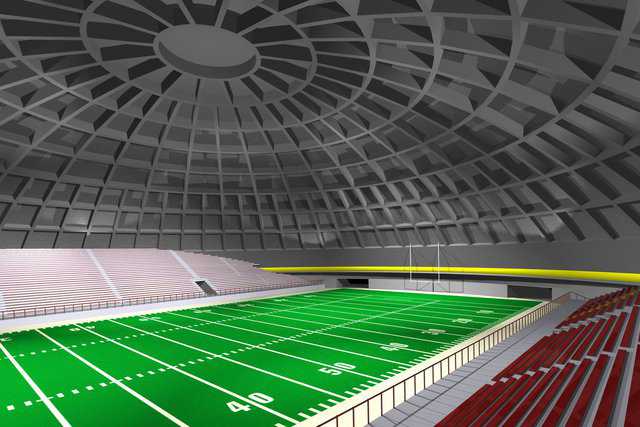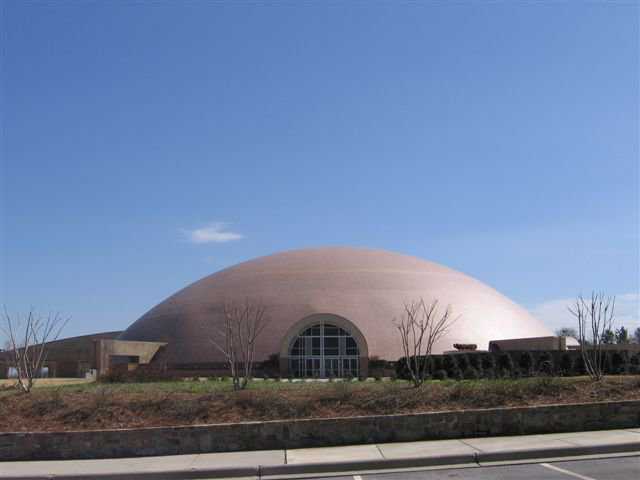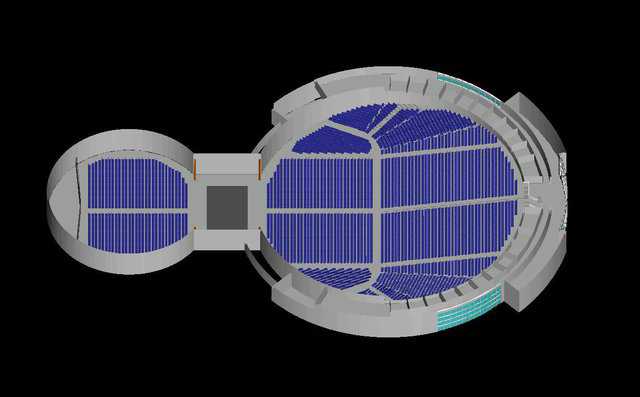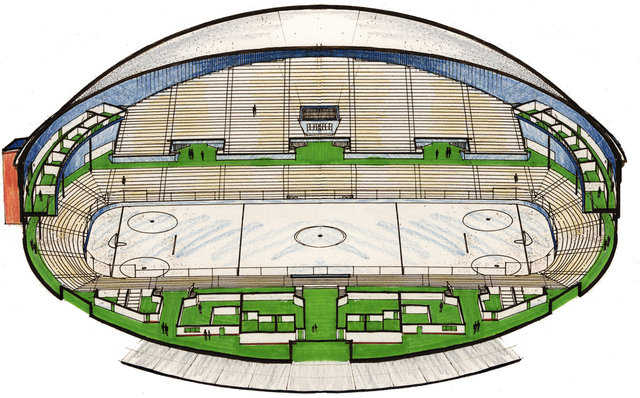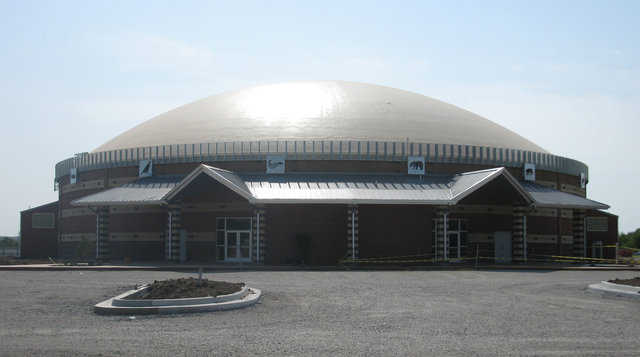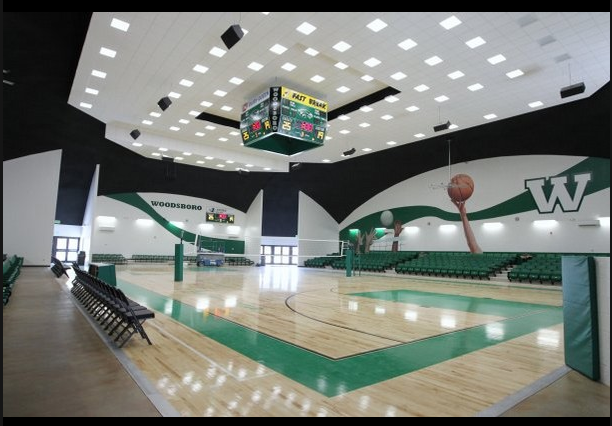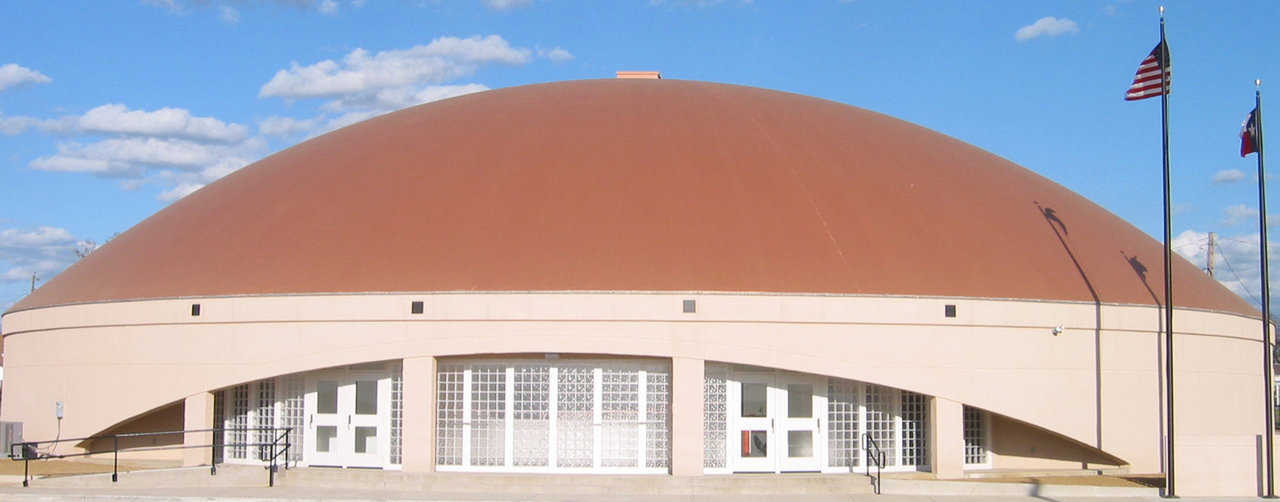
Avalon High School Gym — Designed by Monolithic Architect Rick Crandall and built with a 12’ stemwall, Avalon High School’s Gym measures 124′ × 25′ with a total height of 37 feet.
More about the Monolithic Dome Sports Facility
With a Monolithic Dome you can have the sports facility of your dreams. It can be designed to fit every need—from a simple practice gymnasium to an elaborate fitness center to a giant stadium or arena.
As a sport facility, the Monolithic Dome has significant advantages you can’t afford to ignore.
Design Flexibility – When it comes to design, the Monolithic Dome has traits that make it ideal for any activity:
- Size – A Monolithic Dome sport facility can be small or large. Typically, a gymnasium has a diameter of about 148 feet. But a super arena could be a Crenosphere™ with a diameter of 500 or 600 feet. Then too, the facility could consist of a single-story structure, a multi-story structure or several interconnected domes.
- Clear-span Interior – There are no pillars or posts interrupting the inside of a Monolithic Dome. It does not need or use such architectural supports. Therefore, views from stadium seats, regardless of their location, are clear and uninterrupted.
- Super Strength – Although its interior uses no supporting posts, a Monolithic Dome has tremendous strength. Its walls can support all types of hangings—mezzanines, balconies, galleries, walkways, running tracks, stairways, press boxes, score boards or audio and video housing.
- Lower Construction Costs – It’s a fact! Per square foot, Monolithic Domes cost less to build than other structure types of the same size. And the larger the building, the greater are the savings.
But lower construction costs do not translate into cheap or inferior. You will not sacrifice quality, strength or durability. The very opposite is true.
That’s because of the materials (concrete and steel) and the patented process used in the building of a Monolithic Dome. They make its construction more affordable, but at the same time they create a superior facility.
Timely Construction – It also makes Monolithic Domes a better bargain. Once the Airform®, the dome’s rugged, outer skin, is inflated and stabilized, construction continues on the inside of a Monolithic Dome, unhampered by a lack of daylight or good weather. In other words, workers can go on with the building even at night or when it’s windy, raining, snowing or hailing.
Generally, work delays and stoppages are also avoided because its major materials—the Shotcrete and rebar—used in the dome’s construction are usually and conveniently available.
Construction Management – Monolithic offers Construction Management. It’s a service that keeps you in charge but frees you of day-to-day hassles. Our Construction Manager acts as your consultant during both the design and construction stages. Thus you, the client, stay in control of your project and its cost, while the Construction Manager provides advice and does the daily coordinating and negotiating with contractors and subcontractors.
Design Consultation – Monolithic can provide experienced, professional help to architects and engineers who are new to domes. We also make much information and data available on monolithic.com and in printed form and CDs.
Superior Insulation – Polyurethane foam, sandwiched between a Monolithic Dome’s Airform® and its concrete shell, thoroughly insulates the dome. In essence, this insulating process, that blankets the shell and fills every nook, eliminates air leaks and turns the Monolithic Dome into a self-contained, thermal battery.
So, we claim an effective insulating R-value of 60. That claim is substantiated by actual practice and our customers who have monitored their heating and cooling costs.
For a sport facility, the superior insulation of a Monolithic Dome produces two significant results:
- Energy Efficiency – A Monolithic Dome uses less energy for heating and cooling than do other types of buildings of the same size. Less energy-use means less heating and cooling equipment and less of its maintenance, repair and replacement. That saves money at construction time and in the long run.
- Easy Temperature Control – You may just need a comfortable and healthy environment inside a school gymnasium or fitness center. On the other hand, your facility may be an indoor hockey stadium or an ice skating rink. Whatever the case, a Monolithic Dome can easily, efficiently and economically reach and maintain the temperature you want and need.
Fire Resistance – According to the Uniform Building Code that categorizes structures based on their fire resistance, Monolithic Domes get a high Type II rating. That means that they have a superior ability to resist fire—the concrete shell will not burn—and they qualify for lower insurance rates.
The domes also meet requirements set by the International Building Code since they can be fitted with a sprinkler system that is buried in and protected by concrete.
Security – Easily monitored exits and security checkpoints are standard in a Monolithic Dome sport facility.
Tests have shown that rifle and handgun bullets cannot penetrate the dome’s concrete, and their survival in war-torn areas has proved their ability to withstand explosives and open fire.
Near-absolute Disaster Protection – Monolithic Domes can and have survived tornadoes, hurricanes and earthquakes. They meet or exceed all regional building codes and requirements. They also meet or exceed FEMA’s specifications for a building to provide near-absolute protection against tornadoes and hurricanes.
Many communities have officially made a Monolithic Dome their Community Disaster Shelter, and some have received Red Cross certification as such.
Super-Greenness – Building a Monolithic Dome does not deplete our planet’s forests, nor does it pollute our environment. The domes conserve our natural materials, space and electricity. They require a smaller surface area and use fewer materials to enclose that area. They are perfect candidates for a solar-thermal system that captures and uses free sunlight and heat.
Durability – Monolithic Domes have a lifespan measured in centuries, not years.
Lower Long-Term Maintenance Costs – Generally, a Monolithic Dome needs a minimum of upkeep and maintenance. Its Airform® can be painted or covered with a variety of materials, including but not limited to stucco, concrete or tile.
The dome’s concrete does not attract termites, vermin, mildew, mold or rot.
Since Monolithic Domes are not prone to many common dangers, they usually are less expensive to insure.
Feasibility Study – You can commission a Feasibility Study of the sport facility you want. Such a detailed study, completed by our professional designers and engineers, will give you a realistic, preliminary program with sketches, design details and estimated costs. You can then decide to accept, reject or change your plans.
